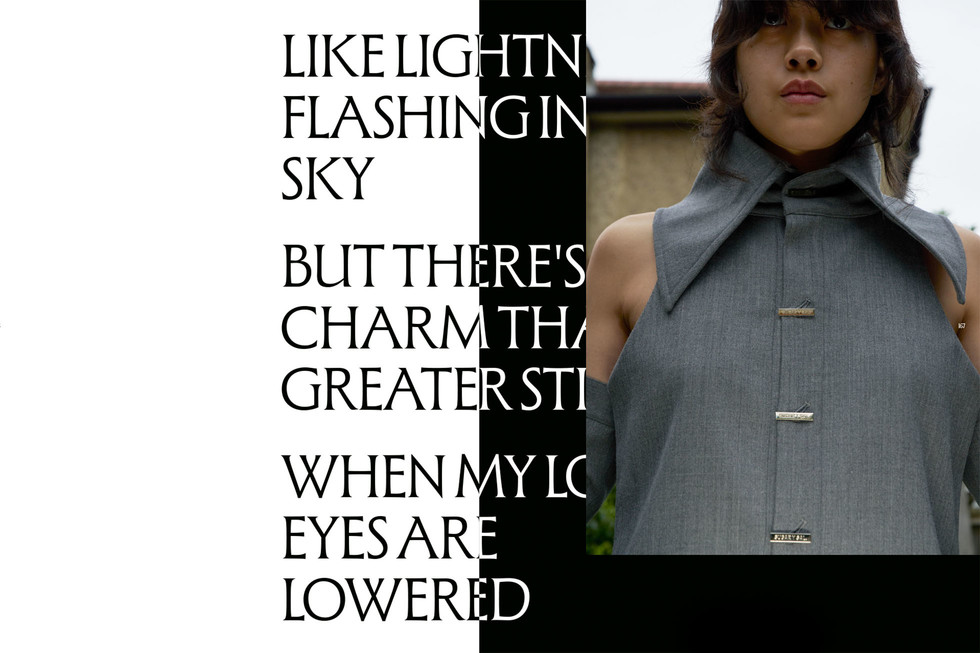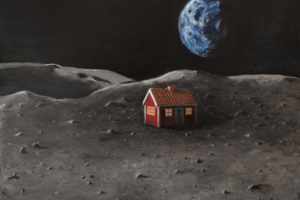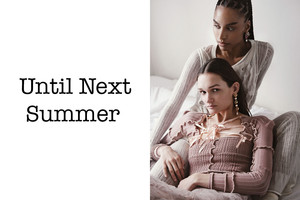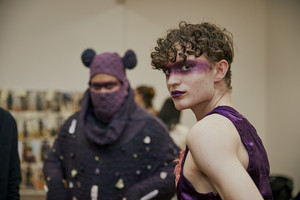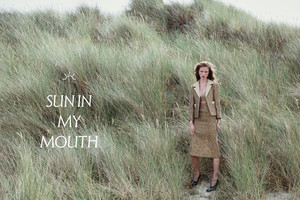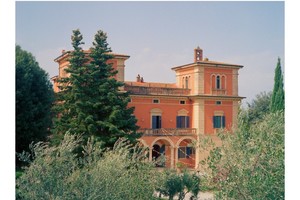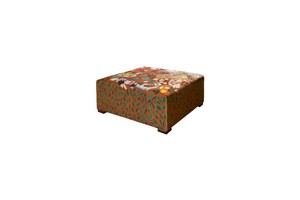Andrea Tsang about ceramics, meaningful design and The Bear
Written by Natalia MunteanAndrea Tsang, founder of the recently opened Studio ANDREA TSANG, transitioned from fast fashion to ceramics in search of an answer to a pressing question: “When we design something, should it just be for design’s sake, or can it last and truly connect with people?” For Andrea, ceramics provided the solution. “When I see people holding a coffee cup I’ve made, they’re not just using it as an object - they appreciate it in their life. It’s about connecting the object to their everyday moments.” Over time, Andrea’s pieces have evolved with refined techniques and consistent quality, but her focus remains steadfast: creating timeless objects that blend East Asian craftsmanship with Scandinavian functionalism. From her coffee cups, born out of her daily hand-drip ritual, to the candle holder featured in The Bear, Andrea's journey embodies a commitment to meaningful design.
Natalia Muntean: Tell me about your beginnings - how did you start working with ceramics?
Andrea Tsang: I studied visual art in Hong Kong and then landed a job as a design assistant at a handbag company. Over ten years, I designed various fashion accessories. Before the pandemic, I worked for a Dutch fast-fashion company as a design manager, enjoying the creativity and travel but feeling disillusioned with the rapid pace of the industry. When the pandemic hit, I was headhunted by a tech company for an innovation team, but the travel and company politics left me feeling unfulfilled. I realised I wanted to do something different. I’d been thinking about going to a pottery studio for a while. In Shanghai, I used to pass a studio and think, “Maybe this weekend, I’ll go there,” but I never did. During the pandemic, I finally called them, and they were open. When I went, it was just me and one teacher in a big studio. It wasn’t my first time on the wheel—I had tried it in university—but back then, it didn’t mean much to me. This time, it felt different. It was just me, my hands, and the clay.
After two classes, I still couldn’t centre the clay properly, but I was determined to practice. I spent a whole week in the studio, morning to evening until I could control the clay with my hands. I felt so happy. I started watching YouTube videos at night and couldn’t wait to get back to the studio the next day. That’s how it started.
Later, I moved to Stockholm and. I thought, “Why don’t I give myself a break?” I quit my job and focused on ceramics. During this time, I made my first coffee cup and shared it on Instagram. People started asking how they could buy my work, so I set up a website and an online shop. That’s how Studio ANDREA TSANG began.
NM: You blend East Asian craftsmanship with Scandinavian functionalism. How do you balance these two pieces?
AT: Where I grew up, in Hong Kong, we have mixed influences from England, Europe, America, and Japan, which have greatly influenced me. I’ve always admired Scandinavian design for its simplicity, minimalism, and the thoughtfulness of its functionality. However, I find it a little too cold for my taste. In contrast, Chinese and Asian cultures emphasize warmth and inviting elements to foster human connection. Therefore, I aim to create a balance between minimalist functionalism and the aesthetics of Chinese and Asian culture. The texture of an object can tell its own story—for instance, a bowl may appear simple at first glance, but upon closer inspection, its unique details, such as trimming marks, reveal that it was handmade.
I believe that the craftsmanship approaches in Asian cultures, like Japanese or Chinese pottery, differ significantly from European methods. I am particularly fascinated by Japanese pottery because of their dedication to perfecting their craft and focusing their lives on creating the ideal cup. This mentality inspires me. While I’m not limited to making just one cup, the mentality of how they treat craftsmanship is really fascinating, and that's what I want to inject into our work as well.
NM: Can you describe the journey from your initial sketches to the final glaze? Do you let yourself be guided by intuition, or do you have a plan?
AT: I don’t usually sketch things at first, like the cups, for example. However, for pieces like the vases, I create some brief sketches at the beginning. What I love about pottery is that I can just mould them with my hands using the clay. Those pieces are one of a kind, but for more functional, everyday objects, I typically refine the form until I'm satisfied with the proportions and the overall look. After that, I create actual proportion sketches that include measurements, since I need to refer to specific sizes when I make them. When someone else is assisting me in the studio, we go back to those sketches, which we call our “Bible.” We document everything, including how thick the handle is, because even though it’s handmade, we still need precise measurements. For one-of-a-kind pieces, I rely more on sketches and then let my intuition guide me as I work with my hands. When it comes to details, like the handle, I don’t have specific size references, but the final touches are guided by my intuition. So, my creative process involves throwing the clay by hand on the wheel, refining it through a few rounds, and then creating a more precise sketch for production. For moulds, I also start with a sketch and then ask someone to help 3D print it for me, which I then use to make a plastic mould. It’s different approaches for different pieces.
NM: Do you have any rituals before you go into the studio? Like, to get yourself into the mood?
AT: Yes! You can’t just go into the studio and start working. First, you have to have a coffee. Coffee is essential! So I sip my coffee and make a mental note of what I need to accomplish that day. I take it slow at first, but I usually start by organising and cleaning the studio. A lot of times, we leave things out from the night before, like brushes that need to be put away. So, yes, I always begin with a cup of coffee - it definitely sets the tone before getting to work!
NM: Your collections, Terra, Mizu and Amphora, have distinct inspirations. Can you share a bit about these narratives and their names?
AT: Terra is inspired by terracotta. It embodies earthy tones, using colour glazes that match the original clay texture. We don’t use a high fire for this. It’s very stable, with a firing temperature of around 1220 degrees, making everything durable while still offering warm earth tones. The concept behind Terra is about hope and ease of integration into everyday life. For example, if you buy one bowl, it will seamlessly blend with other ceramics you may already have. The colour tones are designed to mix and match, allowing you to create a cohesive table setting without needing identical pieces. This makes it versatile and user-friendly for daily life. In our Terra collection, we also offer tableware, espresso cups, and coffee essentials. Recently, we developed kitchenware like an olive oil bottle and matching utensils. I particularly love the olive oil bottle; it’s entirely handmade and has a sculptural quality with a smoothly designed spout. We’ve invested a lot of time in making it work perfectly. The form features simple lines and warm tones. Then we have Mizu - this collection started three years ago when I spent time with my family in Hong Kong. I wanted to create something less precise, focusing on flow, which is central to pottery. It’s about finding beauty in that organic, less structured approach. I found a lovely material, black porcelain, with a beautiful texture that resonates with this concept of life being more about flow than precision. Mizu, which means water in Japanese, embodies this idea. The collection incorporates elements of Ikebana, the Japanese art of flower arrangement. Each piece, made from delicate black porcelain, has its own unique texture, as every item is handcrafted. The goal is to help people appreciate life a little more, allowing them to create beautiful flower arrangements and find calmness in the making process. Finally, we have Amphora, which is also made from stoneware. Amphora is inspired by ancient Greek vessels, which I encountered at a museum. I was fascinated by their dual purpose—functional objects for storing wine or water that have now become decorative items. My work aims to explore this balance between functionality and decoration. I initially designed a candle holder as part of the Amphora collection, which brings a more commercial aspect to this venture, reflecting my desire to provide unique yet usable pieces for the home.
NM: Tell me about the candle holder that was on “The Bear” - how did that happen?
AT: The producer and set designer contacted me in February. She called at 9 PM, and at first, I thought it might be a scam. But when I answered, she asked about placing an urgent order and mentioned emailing and messaging me on Instagram. The request was for 50 candle holders and plates for the new season of The Bear! She wanted the candle holder to be hollow so it could also function as a vase. Although three weeks was a tight timeline, I worked every day to complete the order on time. Afterwards, I realised it was a brilliant idea to make the candle holder hollow, and I designed it to fit a candle insert perfectly. Now it works as both a vase and a candle holder, and it’s been selling really well.
NM: How did it feel to see it in the show?
AT: It gave me goosebumps! The first time I saw it on TV, I was so excited because I had been a big fan of the show since season one. I was just over the moon to see my work on the show!
NM: It sounds like serendipity.
AT: Yes, it feels like it! It was such a big moment for me, and I couldn’t believe it. Knowing my work was on the show was a huge validation, and I was really happy!
NM: What drew you to clay as a medium, and how does it differ creatively and emotionally from, say, fabric and fashion design?
AT: When I was in fashion, I would do sketches, but it’s interesting because when I started making handbags, I realised I had to draw them to scale. If I gave the factory just a nice artistic sketch, they wouldn’t follow it correctly. They might take liberties, and the finished product wouldn’t resemble my original design. In fashion, I relied on someone else to create the sample, which meant waiting for their work. But with clay, I can spend an entire week or day making the sample myself. I don’t always have precise sketches. I usually start with an idea and then work on the wheel, doing several rounds until I feel satisfied with the piece. After that, I create actual sketches for later production. This process feels much more hands-on and fulfilling compared to fashion, which is why I find a great sense of satisfaction in it.
NM: What does success look like for you as a ceramicist and as a business owner?
AT: That's an interesting question. I think that when you’re a ceramicist, you want to try all different things. You might even want to make your own clay and glaze from scratch. However, as a business owner, you need to find a good balance and prioritise because time is limited. I've realised that if you want to truly be successful, you need to have experiences across the board. But now, as a business owner, I also appreciate seeking help from professionals who are specialists - whether they’re experts in glaze or moulds. I love the process of creating, but as a business owner, I don't have the luxury of time. The next step for me is to start looking for someone to help with specific tasks, such as moulds, to increase the quality of the work and also enhance productivity. That's the most important thing. But I'm still enjoying the journey as a ceramicist because that's what keeps me going. If I just focused on the business side, I would lose the authenticity and something I believed in from the very beginning.
NM: So your success is about balance?
AT: Exactly! If I were to switch completely from being a ceramicist to a businesswoman, I'd just pay someone to produce my work, and that's not what I want. I still enjoy creating and showing people how I make things. I’m really happy to share my experiences with others, like how I made my journey happen. Finding that balance with freedom is crucial for me.
NM: What would your dream project be, and what’s next for you?
AT: I think it would involve collaborating with an interior company or a small boutique hotel to design a more homey, tailored environment with my pieces and tableware. I’m excited to express the Andrea Tsang aesthetic and style, not just through individual objects but through the entire dining room experience. I want to cover the whole aesthetic and art direction together. Before, I was focused on the object, but now, if you see our space, our showroom is more like a different room design. So I would definitely want to move from product design and ceramics design to art direction and interior design. Yes, because I think everything is a whole. It's not just separate pieces; everything should look harder as a whole. When people step in, they shouldn’t be distracted by one thing. They should feel the entire environment, feel warmth, and feel invited. I think that’s the most important thing, and that’s what I want to bring to people.









